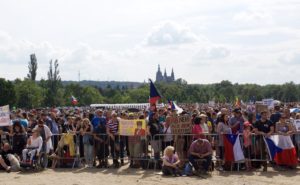Europe’s 12 million Roma make up the largest ethnic minority in the region, yet discrimination against Roma populations is deep-seated, historic and underreported in Eastern Europe—and the Czech Republic is no exception.
Last year, Czech President Milos Zeman said that Roma people were “unadaptable” and unwilling to work, drawing from stereotypes of Romani being lazy.
In New York, activists feel Roma are underrepresented in Holocaust memorandum, given that an estimated 25 percent of Roma in Europe were killed alongside the Jewish population.
Petra Gelbart, a New York-based Czech with Roma ancestry and the granddaughter of Holocaust survivors, estimates that about 90 percent of the Czech Roma population was killed during World War II.
Gelbart, who moved to the United States with her family when she was 10 years old, has become an advocate for Romani rights, and defends the idea that the Roma victims of World War II should receive their due attention in Holocaust commemorations.
“It’s basically a miracle that my mother was born after the war. So I consider it a miracle that I’m alive,” Gelbart said.
Gelbart is also vocal about the discrimination that Roma people experience in today’s Czech Republic, a grisly reminder that the feelings which led to the persecution of her ancestors are far from gone. She has been a target of threats and is listed on an extremist Czech website, “White Media,” which lists enemies of the white race.
Even her children have been harrassed. Gelbart recalled a time when she took her children, ages 2 and 4, to a park when visiting Prague.
“They were with my grandmother and I stepped away for a few minutes,” Gelbart said. “And there was a Czech father who was with his little daughter and he threatened to beat up my kids. He told them that the playground was for white people and that black people weren’t supposed to be on it.”
The stereotypical image of a Roma person in the Czech Republic has darker skin, dark hair, dark eyes—making a darker complexion in the country a disadvantage. And the target of the slur černy, or black in Czech.
Gelbart is also known for her work with Roma music. She is a music curator for the RomArchive, a recently launched initiative to collect international material on Roma culture and history. Through the website and other advocacy efforts, Roma leaders hope to reclaim their culture and history.
Filip Pospisil, another Czech activist based in New York, shared Gelbart’s concerns about their country’s prevailing anti-Roma feelings. “There is very little doubt that there is a deep and widespread racism in Czech society,” he said.
Pospisil was a human rights activist in the Czech Republic for 20 years before moving to New York three years ago. In his work with NGOs, and separately with the Czech government as a part of the Ministry for Human Rights, he experienced first-hand the rise of larger anti-Roma protests throughout the Czech Republic over the last 10 years. As a visiting scholar at the City University of New York, Pospisil continues his activism work from Manhattan. With the Agency for Social Inclusion in the Czech Republic he helps integrate socially excluded persons, such as Roma, within local Czech municipalities.
“You can see more and more that these types of racist discourses are being accepted as part of the political mainstream,” Pospisil said. “You have openly racist parties that are part of the Czech Parliament.”
Pospisil said, however, that it is hard to conclude whether the country is becoming more racist or whether it is just more overt about its racism—and, to a further extent, to understand what is causing it.
Remembering Roma Holocaust victims
Roma, Sinti, Poles, Slavs, homosexuals, and people with disabilities, along with Jews, were considered “racially inferior” by the Nazis and were all victims of the Holocaust. Even so, Gelbart says, Romani representation in Holocaust commemorations is “inadequate” and “just really egregious discrimination.”
Every January, The Holocaust and the United Nations Outreach Programme hosts an International Day of Commemoration in New York in memory of the victims of the Holocaust. Gelbart says she has asked repeatedly for at least five minutes of recognition with a speaker or musician from the Roma community, but her efforts have yet to get through.
Kimberly Mann, chief of the organization’s education outreach and of the commemoration, says they do not mean to be exclusionary, and that “all victims of the Holocaust should be remembered and honored.”
“We try to include Roma in a number of ways,” she said.
Mann explained that the commemoration has different themes each year to honor the many victims of the Holocaust, and that they have had Roma speakers in the past.
However, Gelbart says the Roma community was not consulted in these cases of speakers. “They may say that they are representing Roma, but they’re doing it very tokenistically or they’re just doing it problematically, where instead of letting Roma and Sinti speak for themselves, they will very often let other people speak for us,” she said. “Instead of educating people about who we are, we just get further stereotyped.”
Roma advocates like Gelbart take issue with this because they feel like the impact of the Holocaust on the Roma people is downplayed. Gelbart notes that the resolution adopted by the General Assembly on the Holocaust Remembrance in 2005 does not specifically mention Roma or any other group affected by the Holocaust, but rather “the murder of one third of the Jewish people, along with countless members of other minorities.”
Advocates in the Czech Republic face similar issues. It was not until 2017 that the Czech government removed a pig farm from the location of a Nazi concentration camp in Lety, a city just south of Prague, where hundreds of Roma died. This was following a two-decade attempt to close the farm and create a dignified memorial for the victims.
Roma, also called Romani or Sinti, have been previously referred to as “gypsy.” They are an ethnic minority in Europe with origins in northern India. Europeans mistakenly thought they were from Egypt, which is where the term gypsy came from. The term is now seen as derogatory because of its negative connotations.
There is a common misconception that Roma are a single ethnic group, but there are many different subgroups and cultures. The term Roma also does not mean they are from Romania; Roma populations are located all over the world, mostly in Europe and the Americas, and can look different from community to community.
“Even though the skin color of some Roma might not be that much darker than the average Czech one. People are very sensitive of these kinds of differences,” Pospisil said.
Because of this awareness of different skin colors, Gelbart notices “micro-aggressions” when visiting Prague. Someone will glare at her daughter. Another will shove her son out of the way on a bus.
In Czech Republic, Pospisil said that his colleagues in activist circles are currently “quite skeptical about further development” of Roma rights. And Gelbart says that Roma people she knows are very nervous and play close attention to politics in Eastern Europe for hints of another genocide.
But a sign of hope for both Pospisil and Gelbart is a new trend of a wider civil society that are hosting more and more counter-protests in the Czech Republic to point out this discrimination.
In July, after a Romani kindergarten was burned to the ground in Ukraine, Roma and activists marched to the Ukrainian Embassy in Prague. Gelbart took part in this demonstration. In October, the seventh annual Roma Pride event assembled in Prague despite pouring rain.
PHOTO: Street performance during the Khamoro (World Roma Festival) in Prague, May 2007. Source: Jialiang Gao /Wikimedia Commons. Filed under CC.






Be First to Comment